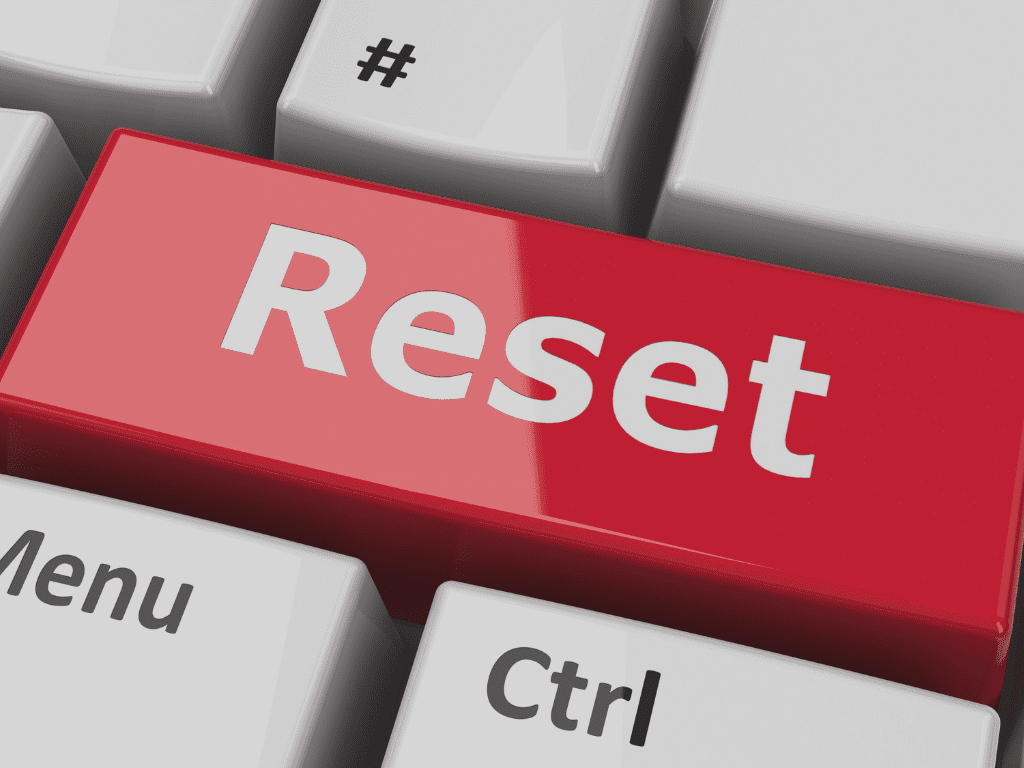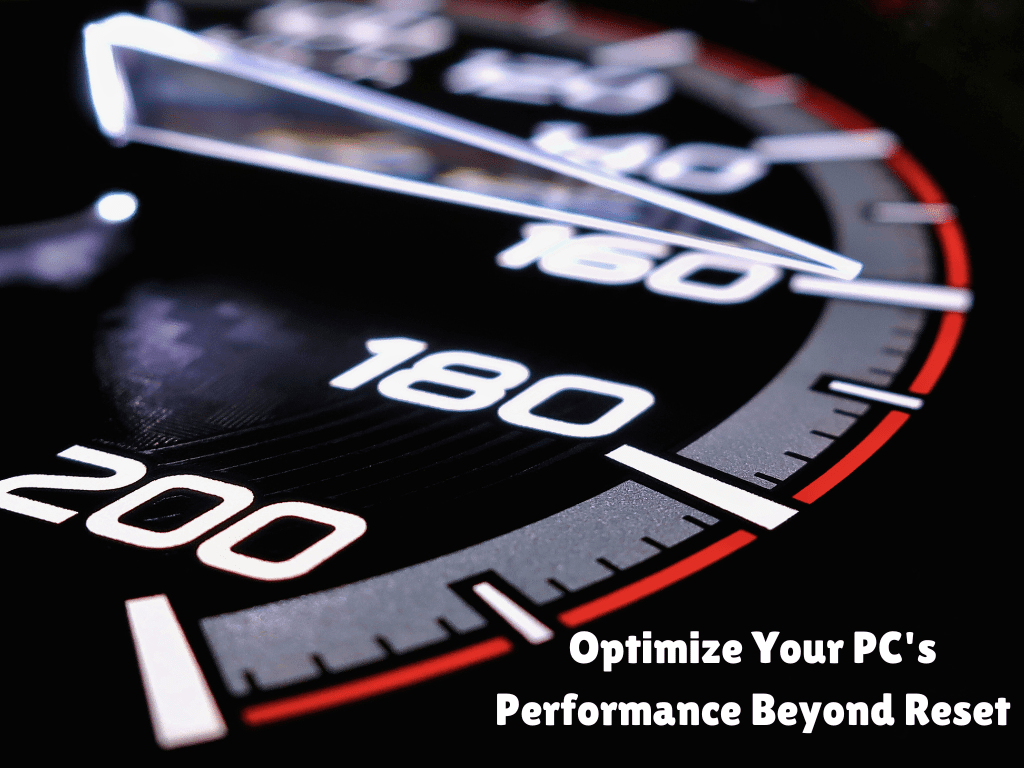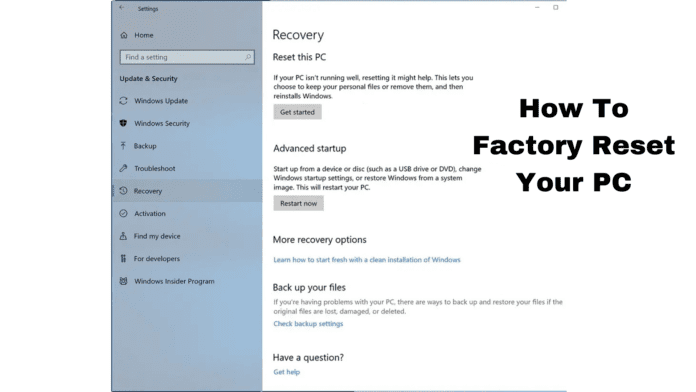Is your computer feeling sluggish? What do you think— Is it plagued by software glitches or malware? Well, in both cases a factory reset is surely what you need to take everything back to the norm. Think of it as a digital spring cleaning to give your PC a fresh start.
In this article, we’ll provide you with a complete step-by-step guide how to factory reset your PC so that you can breathe new life into your computer.
In this article we’ll cover:
- What a factory reset is?
- When to consider a factory reset?
- How to prepare for a factory reset?
- Step-by-step instructions
- Additional tips and considerations
Let’s get started!
Also Read More: How To See Your PC Specs Window 10 and Window 7?
What is a Factory Reset?
A factory reset means erasing all your user data and configurations and returning your PC to its ‘factory’ state. Unlike uninstalling or removing a user profile — a factory reset is about taking your device back to the condition how it first came out of the box.
This means everything from your personal files to custom settings is erased, leaving you with a clean slate. It will preserve no cache, files, images, media, passwords, or other data a user may have saved or downloaded while using a device.
What Does a Factory Reset Do?
When you perform a factory reset, you simply restore the device to its original system state by erasing all stored information. This includes contacts, messages, photos, apps, and anything else you’ve added. It’s a powerful way that help you to regain control of your device and resolve various issues.
Why Do We Factory Reset Our Device?
Factory resets are especially useful for fixing software problems, such as operating system errors and performance lag issues. You can often solve persistent issues and make your PC run smoothly again by resetting your device to its original state. From troubleshooting, or preparing to sell your device, to just giving your system a fresh start, factory reset is indeed an effective way to get your device back to its best condition.

But before you decide to Factory reset your device, here are some facts that you should keep in consideration:
- Data loss: Factory resets completely erase all personal data, including contacts, messages, photos, videos, and installed apps. Therefore, it’s crucial to back up any important files before performing a factory reset.
- Software restoration: A factory reset returns the device to its original software configuration, as it was when it left the factory. Thence, it is only necessary when you want to resolve software issues or prepare the device for sale or transfer.
- Different methods: The specific steps to perform a factory reset may vary depending on the device and operating system. However, it’s usually done through the device’s settings menu.
Reasons for performing a factory reset
A factory reset is useful in many situations. If your PC has issues, you’re selling it, or you just want a clean it, the factory reset is all you need to give your system a new start. Here are some reasons why users usually opt for a factory reset:
- Troubleshooting device issues: If your device is experiencing problems like slow performance, freezing, or app crashes, a factory reset can sometimes resolve these issues.
- Preparing to sell or give away a device: To ensure that all your personal data is removed from the device before transferring ownership.
- Starting fresh: If you simply want to start over with a clean slate and remove all your customizations.
Related : How to Uninstall the Default Apple Apps on Mac?
How To Factory Reset Your PC?
You can factory reset your device in two ways—by using the settings app, and by using the BIOS. Here is a step-by-step guide for both to help you reset your device and take it back to its factory state. So, keep reading.
Method 1: Using the Settings App
- Click the Start button and select Settings.
- Go to Update & Security > Recovery.
- Click “Reset this PC” and then “Get started.”
- Select either “Keep my files” (to retain personal files) or “Remove everything” (for a complete reset).
- Follow the on-screen prompts to confirm your choice and begin the reset process.
Method 2: Using the BIOS
- Power off your computer and then turn it back on.
- Press the designated key (usually F2, F10, or Delete) during the startup process.
- Use the arrow keys to find the “Reset” or “Load Defaults” option.
- Save the changes and exit the BIOS.
- Your PC will restart and begin the factory reset process.
How To Prepare Your PC for a Factory Reset?
Before you start a factory reset, it’s important to prepare. First, back up your important data. You should make sure you have copies of your files stored on an external drive, cloud storage, or another safe location. Thence, you don’t lose anything valuable.
Next, note your Windows product key. You’ll need it later to activate Windows after the reset. Moreover, you should also try to uninstall any unnecessary programs beforehand.
This will help free up space and improve your computer’s performance before you reset it. Taking these steps will make the process smoother and ensure you’re ready for a fresh start.
How To Factory Reset Window?
Factory resetting your Windows PC can help fix problems or give you a fresh start. Here is a quick step-by-step guide to help you factory rest your Window and Window 11 and give your PC a new life. Before we get in — Shall I tell you a fun fact: Windows offers you a choice whether you want to keep your personal files during factory reset or remove everything. Keep reading, to know more about how to factory reset your Window PC.
How to Factory Reset Windows 10?
Option 1: From Settings
- Click on the Start menu (Windows icon) and select Settings (gear icon).
- In the Settings window, choose Update & Security.
- From the left menu, click Recovery.
- Under Reset this PC, click the Get started button.
- You will be given two options. If you want to remove apps and settings but keep your personal files, then select Keep my files. However, if you want to erase all files, apps, and settings, then opt for Remove everything.
- You can choose Cloud download to download a fresh copy of Windows from Microsoft servers, or go for Local reinstall to use the files that are already avalable on your PC.
- Confirm your choice by clicking Next, then click Reset to start the process.
- Wait for the process to finish. Your PC will restart and return to its factory settings.
Option 2: Without a Password (From the Login Screen)
- On the login screen, press and hold the Shift key, then click Restart.
- After your PC restarts, select Troubleshoot from the menu that appears.
- Click on Reset this PC.
- Choose either Keep my files or Remove everything, depending on your personal preferences. (as mentioned before)
- Choose between Cloud download or Local reinstall for reinstalling Windows.
- Click Reset to start the process. Your PC will restart and return to factory settings.
How to Factory Reset Windows 11?
- Open Settings by clicking the Start menu and selecting Settings.
- In the left-hand menu, select System, then scroll down and click Recovery.
- Under Reset this PC, click the Reset PC button.
- Choose between Keep my files (to remove apps and settings but keep personal files) or Remove everything (to wipe the PC completely).
- Select Cloud download to download Windows from Microsoft’s servers, or Local reinstall to use the files already on your PC.
- Click Next, then click Reset to start the process.
- Wait for the process to complete. Your PC will restart and be restored to its original factory settings.
Factory Reset vs. Reinstalling: Which is Better?
The choice between a factory reset and reinstalling Windows depends on your specific needs and goals. Here’s a breakdown of the key differences:
Factory Reset
- Deletes all personal data, settings, and installed programs.
- Returns your PC to its factory settings.
Reinstalling Windows
- Preserve your documents, photos, videos, and other personal data.
- Erases all installed software and system settings.
Which one to Choose?
If you’re selling or giving away your PC, then factory reset is a wise choice. It ensures that no personal data remains on the device. This way, the new owner gets a clean slate without your files.
Moreover, if your computer has persistent issues, such as software problems or malware, a factory reset can often resolve these. It’s also ideal if you want to start fresh with a completely clean system.
On the other hand, if you want to keep your personal files, reinstalling Windows is a better option. This allows you to update your operating system or fix software conflicts and keeps your data safe.
Read More to learn: How To Make PS4 Controller Vibrate?
How To Optimize Your PC’s Performance Beyond Reset?
Here are some of the ways that will surely help you improve your system’s performance without a complete or factory reset.

- Update regularly: Keep operating systems, device drivers, and software up-to-date for optimal performance and security.
- Manage startup programs: Disable unnecessary programs to reduce startup time and improve system resources.
- Free up disk space: Delete temporary files, cached data, and unused programs to improve performance and prevent slowdowns.
- Adjust power settings: Choose a balanced power plan for optimal performance and energy efficiency. Customize settings like screen brightness and sleep mode.
- Check for hardware issues: Use diagnostic tools to scan for hardware errors and address them promptly. Monitor CPU and GPU temperatures to ensure they are within normal operating ranges,
- Consider upgrading hardware: If your PC is struggling to handle demanding tasks, upgrade components like RAM or storage to improve performance.
- Use performance optimization tools: Research and choose reputable tools carefully, as some can introduce problems. Consider using tools like CCleaner or AVG TuneUp.
- Maintain regular maintenance: Clean up your PC regularly by removing dust, running antivirus scans, and defragmenting your hard drive (if using a traditional HDD).
Key Takeaways
- Factory Reset
Completely erases all data and settings, returning your device to its original state as if it were brand new. It is ideal if you want to sell or give away your PC, or just need to resolve persistent system issues.
- Preparation
Before starting a factory reset, back up your data, note your Windows product key, and uninstall any unnecessary programs to ensure a smooth process.
- Data Backup
Always back up your important files before performing a factory reset to prevent data loss.
- Reinstalling Windows
Keeps your personal files while removing installed programs and settings. This makes it suitable for troubleshooting or upgrading your system.
- PC Optimization
Regularly update your system, manage startup programs, free up disk space, and check for hardware issues to maintain and improve your PC’s performance. Therefore, you should consider hardware upgrades to maintain a smooth system performance.
Conclusion
Remember, a factory reset can bring your PC back to its original state. It’s a great option if you’re dealing with issues, want to sell your device, or need to clean it. But you should ensure that you back up your data first.
However, if you want to keep your files while fixing problems, reinstalling Windows might be the better choice for you. And don’t forget—regular updates, managing startup programs, and other simple optimizations can keep your PC running smoothly for longer.

